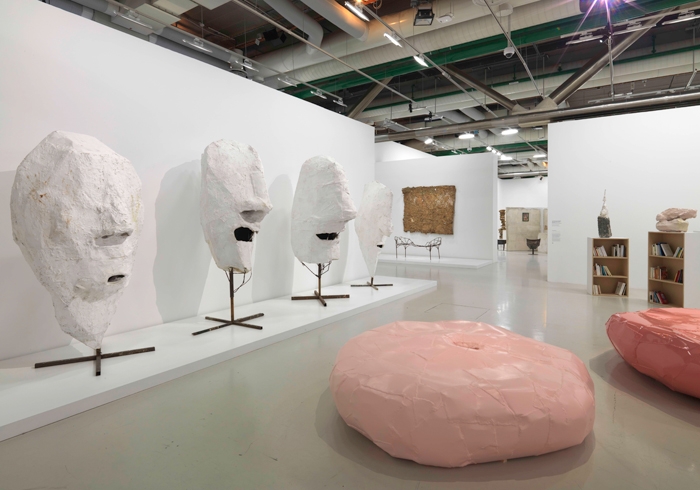Emerging in an early-1970s Viennese art scene dominated by the legacy of the Wiener Gruppe and the meteoric rise of the Actionists, Franz West, unsurprisingly, was a loner for much of his career. A great believer in the potency of pleasure, he approached artmaking with a playful, mind-drifting everydayness, fusing it with social functionality – hardly in line with the heroic expressivity of the Wiener artists’ post-Dadaism nor with the severe, messianic existentialism of Actionism.
The first largescale institutional retrospective of West’s work – coproduced by Centre Pompidou and Tate Modern, to where the show travels in February – serves most of all as an exhaustive archival mission, setting out to catalogue a vast body of work that defies any standardised categorisation. Of West’s identified corpus of nearly 6,000 works, a couple of hundred are present here. The scenography, devised by longtime friend Sarah Lucas and containing drawings, videos, outdoor sculpture, paintings, furniture, etc, is realised in a carefree, pleasantly cluttered manner, vaguely resembling an artist’s studio or home, with discrete environments located in corners, passages and plinths bringing the viewer into the artist’s hard-to-explain but instantly recognisable aesthetic universe.
Organised chronologically – with the exception of the installation Auditorium (1992), consisting of 72 rugged divans in the entrance hall on which visitors are encouraged to sit, first presented at Documenta 9 – the exhibition begins with West’s Mutter Kunst series (1970–73): unassuming little ballpoint drawings conceived to please his mother, who wanted to see him doing something productive with his life. While formally occupying the extreme poles of the artist’s oeuvre, the blatantly utilitarian purpose of both the installation and the drawings – to rest, to please – feels illustrative, and bleeds nicely into West’s most famous body of work, the Passstucke, or Adaptives, which he started in 1974; smallish, organically shaped sculptures devised as removable prostheses to be picked up, carried and walked around with in and outside the exhibition space. What perhaps seem like a redundant gesture in today’s post-relational aesthetics institution feels surprisingly effective still, audiences improvisatorially engaging the objects like toys or fashion accessories.

Indeed, not only did West with his Passstucke reintroduce the corporeal into sculpture, renegotiating its relationship to the human body; he contested the medium’s modernist claim to autonomy and clashed it (rather absurdly) with the formal language of interior design. Touching up against such antithetical realms of aesthetics makes West’s objects all the more transgressive, as well as cognisant of the sensorial porosity between such categories. The body doesn’t discriminate between toy and artwork, divan and sculpture, but looks always for pleasure and comfort, as Freud – West’s longtime hero – once posited it.
West’s extensive sculptural repertoire is wonderfully elaborated in his monochrome papier-mâché sculptures as well as those that organically engulf found objects such as bottles (the Labstücke series, 1986). His colour work is another important topic: from loud sensuous reds to questionable murky greens and browns, West plays deliberately on the immediacy of corporeal responses to various hues. Indeed, as apparatus, image and form, the body emerges as a driving force for West: a body that eats, drinks, pisses, sleeps, reads, converses. Although a devout Viennese intellectual, much of his work escapes classic psychoanalytic readings. For example, Serie: ‘Die Sexualität’ (1975) – ballpoint cartoons of mundane heterosexual intercourse – critiques bourgeois sexual comfort more than it explores deeper Freudian themes of desire. Satire is a difficult rhetoric in art history, particularly when embroiled in some of the most genuine and human explorations into shape and form seen in twentieth-century art, and it’s this tension that makes West’s sculptural strategy so alluring. Add a Wittgensteinian engagement with language and syntax in his titles, which point to deeper or contradictory meanings: the steel sculpture Causeuse (1988–89), for example, suggests a small double-seated sofa but also a woman who chats, while Deutscher Humor (1987) – a freestanding cluster of papier-maché and metal wrapped around a broomstick – reveals a buttholelike crevice, perhaps referencing the German proverb of having a ‘stick up one’s ass’.
Engaging these corporeal, psychic and linguistic registers of sculpture-making with an amateur’s irreverent enthusiasm, West emerges here as a truly remarkable maker of his time, a predecessor to a whole range of later practice, not least Gelitin and the aforementioned Lucas. Defying all heroism, West’s avant-gardism approaches art as a system that life both fits into and overflows.
Franz West, Centre Pompidou, Paris, 12 September – 10 December 2018; Tate Modern, 20 February – 2 June 2019
From the December 2018 issue of ArtReview
